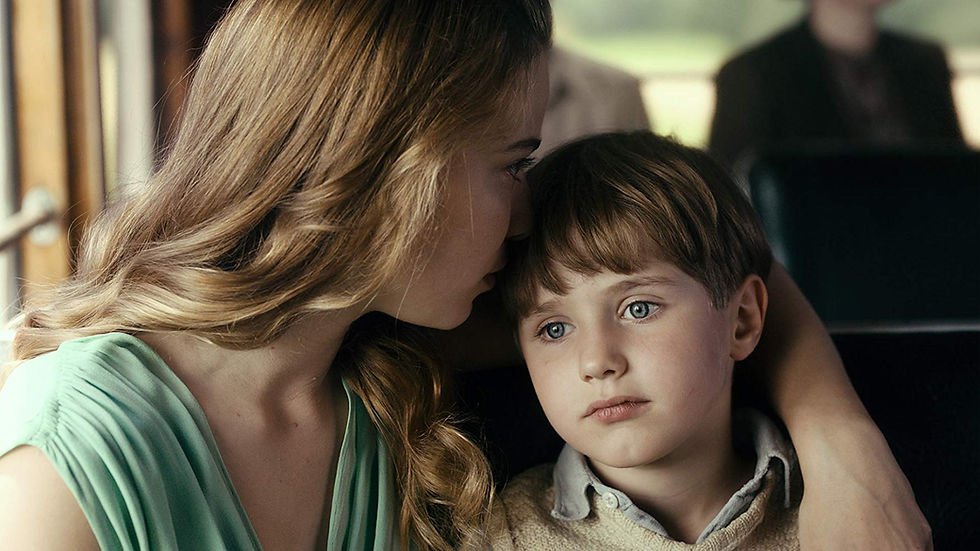Art reveals reality in “Never Look Away”
- High-Def Watch Staff
- May 22, 2019
- 3 min read
BLU-RAY REVIEW


“NEVER LOOK AWAY”
Blu-ray and DVD; 2018; R for graphic nudity, sexuality, and brief violent images; streaming via Amazon Video/Prime, FandangoNOW, Google Play, iTunes, Vudu, YouTube
Best extra: Only extra is Q&A with writer/director Florian Henckel von Donnersmarck
THE GERMAN language film “Never Look Away,” which was nominated for two Oscars including Best Foreign Film, examines the life of an artist.
Inspired by the story of a real person, the German abstract painter Gerhard Richter, the 3-hour-plus saga of Kurt (Tom Schilling) begins in Dresden when he’s about seven years old. His pretty young Aunt Elisabeth May (Saskia Rosendahl) has taken her little nephew to the “decadent art” exhibit of 1937, with which the Nazis ridiculed examples of modern expressionist paintings. The party preferred stylized depictions of Aryan “perfection” and condemned the artists such as George Grosz and Otto Dix, whose often grotesque imagery illustrated the horrors of war and the depravity of German society at the time. At the exhibit, Elisabeth whispers in Kurt’s ear that she actually likes the work on display. But we soon see that the young woman shows signs of mental illness.



One day, Kurt witnesses a terrifying scene: Elisabeth is wrenched away from home by uniformed medical workers and thrown into an institution. Examined by gynecologist Carl Seeband (Sebastian Koch) in league with the Nazis, Elisabeth is initially a candidate for forced sterilization, but eventually, the doctor condemns her to the fate suffered by most German citizens with physical or mental handicaps: annihilation. The years pass and Kurt lands in the Düsseldorf University, where he begins his serious art studies. There, he meets and falls in love with Ellie (Paula Beer), a beautiful fashion design student. What he doesn’t realize is that Ellie’s father, a gynecologist, was part of the Nazi medical community that sent so many to their deaths. It was he, in fact, who examined and condemned Kurt’s Aunt Elisabeth. And, as contrived as that may sound, it was what actually occurred in Richter’s life.
This Sony Blu-ray transfer is state-of-the-art, with a beautifully crisp picture, plenty of fine detail, and naturalistic skin tones. The audio is also faultless, with German dialogue sharp, and sound effects perfectly modulated. English subtitles are, naturally, provided.
EXTRAS
During the Q&A at a showing of “Never Look Away” in New York City, Von Donnersmarck (“The Life of Others”) explains how the project developed. He says that for a long time, he had been looking for a story about the creative process. After giving up on his first idea, which was to have as his subject the composer of an opera, he read an article and a book about Richter. A journalist wrote them both and, in the course of his research, the writer made the discovery about Richter’s father-in-law’s possible involvement in his aunt’s murder.
Von Donnersmarck spent time interviewing Richter and saw the original photos the artist used as subject matter for his paintings. The director notes how the photos by themselves are quite uninteresting, but Richter’s treatment of them gave them tremendous power. Von Donnersmarck says he wanted to look at the Nazi era in “a fresh way” – not caricatured: “How does the seduction of evil work?” He notes that both doctors and teachers “had an awful track record in that time … they had been used to a bizarre type of power … and the ‘sweet nectar’ of that much more power was irresistible for most of them.”

The director discusses his choice of six-time Oscar-nominated cinematographer, Caleb Deschanel, who typically works on big Hollywood productions. Von Donnersmarck had been a fan of Deschanel’s work from his first film, “The Black Stallion.” Deschanel agreed to work on “Never Look Away” after meeting with von Donnersmarck before the screenplay was even written.
Von Donnersmarck says Düsseldorf was “where German art was reborn” after the war. He cites Joseph Beuys, the real-life conceptual artist who died in 1986, as inspiration for the character of Kurt’s teacher – and mentor – at the university. The director notes that Kurt’s paintings in the film, which closely resemble those of Richter, were actually painted by one of the artist’s longtime assistants.
— Peggy Earle
MOVIE TRAILER



Comments